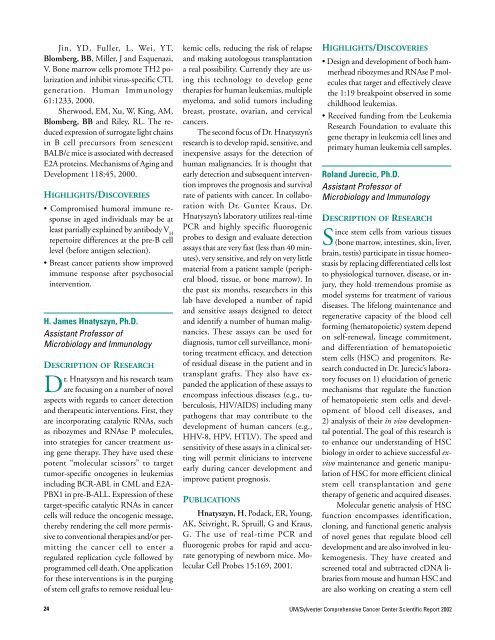tumor cell biology program - Sylvester Comprehensive Cancer Center
tumor cell biology program - Sylvester Comprehensive Cancer Center
tumor cell biology program - Sylvester Comprehensive Cancer Center
You also want an ePaper? Increase the reach of your titles
YUMPU automatically turns print PDFs into web optimized ePapers that Google loves.
Jin, YD, Fuller, L, Wei, YT,<br />
Blomberg, BB, Miller, J and Esquenazi,<br />
V. Bone marrow <strong>cell</strong>s promote TH2 polarization<br />
and inhibit virus-specific CTL<br />
generation. Human Immunology<br />
61:1233, 2000.<br />
Sherwood, EM, Xu, W, King, AM,<br />
Blomberg, BB and Riley, RL. The reduced<br />
expression of surrogate light chains<br />
in B <strong>cell</strong> precursors from senescent<br />
BALB/c mice is associated with decreased<br />
E2A proteins. Mechanisms of Aging and<br />
Development 118:45, 2000.<br />
HIGHLIGHTS/DISCOVERIES<br />
• Compromised humoral immune response<br />
in aged individuals may be at<br />
least partially explained by antibody V H<br />
repertoire differences at the pre-B <strong>cell</strong><br />
level (before antigen selection).<br />
• Breast cancer patients show improved<br />
immune response after psychosocial<br />
intervention.<br />
H. James Hnatyszyn, Ph.D.<br />
Assistant Professor of<br />
Micro<strong>biology</strong> and Immunology<br />
DESCRIPTION OF RESEARCH<br />
Dr. Hnatyszyn and his research team<br />
are focusing on a number of novel<br />
aspects with regards to cancer detection<br />
and therapeutic interventions. First, they<br />
are incorporating catalytic RNAs, such<br />
as ribozymes and RNAse P molecules,<br />
into strategies for cancer treatment using<br />
gene therapy. They have used these<br />
potent “molecular scissors” to target<br />
<strong>tumor</strong>-specific oncogenes in leukemias<br />
including BCR-ABL in CML and E2A-<br />
PBX1 in pre-B-ALL. Expression of these<br />
target-specific catalytic RNAs in cancer<br />
<strong>cell</strong>s will reduce the oncogenic message,<br />
thereby rendering the <strong>cell</strong> more permissive<br />
to conventional therapies and/or permitting<br />
the cancer <strong>cell</strong> to enter a<br />
regulated replication cycle followed by<br />
<strong>program</strong>med <strong>cell</strong> death. One application<br />
for these interventions is in the purging<br />
of stem <strong>cell</strong> grafts to remove residual leukemic<br />
<strong>cell</strong>s, reducing the risk of relapse<br />
and making autologous transplantation<br />
a real possibility. Currently they are using<br />
this technology to develop gene<br />
therapies for human leukemias, multiple<br />
myeloma, and solid <strong>tumor</strong>s including<br />
breast, prostate, ovarian, and cervical<br />
cancers.<br />
The second focus of Dr. Hnatyszyn’s<br />
research is to develop rapid, sensitive, and<br />
inexpensive assays for the detection of<br />
human malignancies. It is thought that<br />
early detection and subsequent intervention<br />
improves the prognosis and survival<br />
rate of patients with cancer. In collaboration<br />
with Dr. Gunter Kraus, Dr.<br />
Hnatyszyn’s laboratory utilizes real-time<br />
PCR and highly specific fluorogenic<br />
probes to design and evaluate detection<br />
assays that are very fast (less than 40 minutes),<br />
very sensitive, and rely on very little<br />
material from a patient sample (peripheral<br />
blood, tissue, or bone marrow). In<br />
the past six months, researchers in this<br />
lab have developed a number of rapid<br />
and sensitive assays designed to detect<br />
and identify a number of human malignancies.<br />
These assays can be used for<br />
diagnosis, <strong>tumor</strong> <strong>cell</strong> surveillance, monitoring<br />
treatment efficacy, and detection<br />
of residual disease in the patient and in<br />
transplant grafts. They also have expanded<br />
the application of these assays to<br />
encompass infectious diseases (e.g., tuberculosis,<br />
HIV/AIDS) including many<br />
pathogens that may contribute to the<br />
development of human cancers (e.g.,<br />
HHV-8, HPV, HTLV). The speed and<br />
sensitivity of these assays in a clinical setting<br />
will permit clinicians to intervene<br />
early during cancer development and<br />
improve patient prognosis.<br />
PUBLICATIONS<br />
Hnatyszyn, H, Podack, ER, Young,<br />
AK, Seivright, R, Spruill, G and Kraus,<br />
G. The use of real-time PCR and<br />
fluorogenic probes for rapid and accurate<br />
genotyping of newborn mice. Molecular<br />
Cell Probes 15:169, 2001.<br />
HIGHLIGHTS/DISCOVERIES<br />
• Design and development of both hammerhead<br />
ribozymes and RNAse P molecules<br />
that target and effectively cleave<br />
the 1:19 breakpoint observed in some<br />
childhood leukemias.<br />
• Received funding from the Leukemia<br />
Research Foundation to evaluate this<br />
gene therapy in leukemia <strong>cell</strong> lines and<br />
primary human leukemia <strong>cell</strong> samples.<br />
Roland Jurecic, Ph.D.<br />
Assistant Professor of<br />
Micro<strong>biology</strong> and Immunology<br />
DESCRIPTION OF RESEARCH<br />
Since stem <strong>cell</strong>s from various tissues<br />
(bone marrow, intestines, skin, liver,<br />
brain, testis) participate in tissue homeostasis<br />
by replacing differentiated <strong>cell</strong>s lost<br />
to physiological turnover, disease, or injury,<br />
they hold tremendous promise as<br />
model systems for treatment of various<br />
diseases. The lifelong maintenance and<br />
regenerative capacity of the blood <strong>cell</strong><br />
forming (hematopoietic) system depend<br />
on self-renewal, lineage commitment,<br />
and differentiation of hematopoietic<br />
stem <strong>cell</strong>s (HSC) and progenitors. Research<br />
conducted in Dr. Jurecic’s laboratory<br />
focuses on 1) elucidation of genetic<br />
mechanisms that regulate the function<br />
of hematopoietic stem <strong>cell</strong>s and development<br />
of blood <strong>cell</strong> diseases, and<br />
2) analysis of their in vivo developmental<br />
potential. The goal of this research is<br />
to enhance our understanding of HSC<br />
<strong>biology</strong> in order to achieve successful exvivo<br />
maintenance and genetic manipulation<br />
of HSC for more efficient clinical<br />
stem <strong>cell</strong> transplantation and gene<br />
therapy of genetic and acquired diseases.<br />
Molecular genetic analysis of HSC<br />
function encompasses identification,<br />
cloning, and functional genetic analysis<br />
of novel genes that regulate blood <strong>cell</strong><br />
development and are also involved in leukemogenesis.<br />
They have created and<br />
screened total and subtracted cDNA libraries<br />
from mouse and human HSC and<br />
are also working on creating a stem <strong>cell</strong><br />
24<br />
UM/<strong>Sylvester</strong> <strong>Comprehensive</strong> <strong>Cancer</strong> <strong>Center</strong> Scientific Report 2002
















